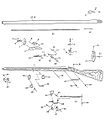Charleville musket facts for kids
Quick facts for kids Charleville musket |
|
|---|---|
| Type | Musket |
| Place of origin | Kingdom of France |
| Service history | |
| In service | 1717-1840 |
| Used by | France, various native Canadian tribes and other tribes throughout New France, United States |
| Wars | Indian wars, Austrian War of Succession, Karnatic Wars, Seven Years' War, American Revolutionary war, French Revolutionary Wars, Napoleonic Wars, War of 1812 |
| Production history | |
| Designed | 1717 |
| Produced | 1717–1839 |
| No. built | > 150,000 (Modèle 1766) |
| Specifications | |
| Mass | 10 pounds (4.5 kg) |
| Length | 60 inches (150 cm) |
| Barrel length | 45 inches (110 cm) |
|
|
|
| Caliber | .69" (17.5mm) |
| Action | Flintlock |
| Rate of fire | User dependent; usually 2 to 3 rounds a minute, an expert 4 |
| Effective firing range | 100 to 200 yards, max 50 to 75 in reality |
| Feed system | Muzzle-loaded |
The Charleville muskets were powerful French smoothbore flintlock muskets. They were used in the 1700s and 1800s. These muskets fired a .69 caliber bullet.
The Charleville musket was very important during the American Revolutionary War. Both American and French soldiers used it. The United States later copied its design. They made their own version called the Springfield Model 1795 Musket.
Contents
History of the Charleville Musket
Around 1630, a Frenchman named Marin le Bourgeoys created the first "true" flintlock mechanism. He worked for King Louis XIII of France. This invention was a big step forward for firearms.
In 1717, the first standard "Charleville" flintlock musket was made. It was designed for the French military. This musket became the official weapon for all French soldiers.
These muskets are often called "Charleville muskets." This name comes from the armory in Charleville-Mézières, France. However, they were also made in other places like Tulle and St. Etienne. During the American Revolutionary War, Americans often called all French muskets "Charlevilles."
The design of the Charleville musket was improved many times. Newer models stayed in use until 1840. By then, newer percussion lock systems made the flintlock outdated.
How the Charleville Musket Was Designed
Charleville muskets had a smooth barrel, meaning the inside was smooth. Rifles have grooves inside their barrels, which makes them more accurate. However, military commanders preferred smoothbore muskets in battle.
This was because both types of guns used black powder. Black powder caused a lot of smoke and dirt inside the barrel. Rifles became very hard to load after just a few shots. Smoothbore muskets were easier to load quickly.
The Charleville musket was accurate up to about 110 yd (100 m) against a group of soldiers. It was accurate up to 40 to 50 yd (37 to 46 m) against a single person.
The Charleville's barrel was .69 inches (17.5mm) wide. This was a bit smaller than the British Brown Bess musket, which was .75 caliber. The smaller size made the Charleville lighter for soldiers to carry. Its stock, or handle, was usually made from walnut wood.
Soldiers did not use Charleville muskets like modern rifles. They fired them in large groups, standing close together. Firing muskets often prepared the way for a bayonet charge. A bayonet is a knife attached to the end of the musket.
With a bayonet, the musket could be used like a pike in close Hand-to-hand combat. This is why the Charleville was long and heavy. It needed to be long enough to be a pike and heavy enough to be a club. But it also had to be light enough for soldiers to carry and use.
A skilled soldier could fire about three shots per minute. After 1728, three metal bands held the barrel in place. This made the musket much stronger. In 1743, the wooden ramrod was replaced with a steel one. More improvements were made in the 1750s and 1760s. The 1766 model was lighter than the 1763 version.
Images for kids
See also
 In Spanish: Mosquete Charleville para niños
In Spanish: Mosquete Charleville para niños





